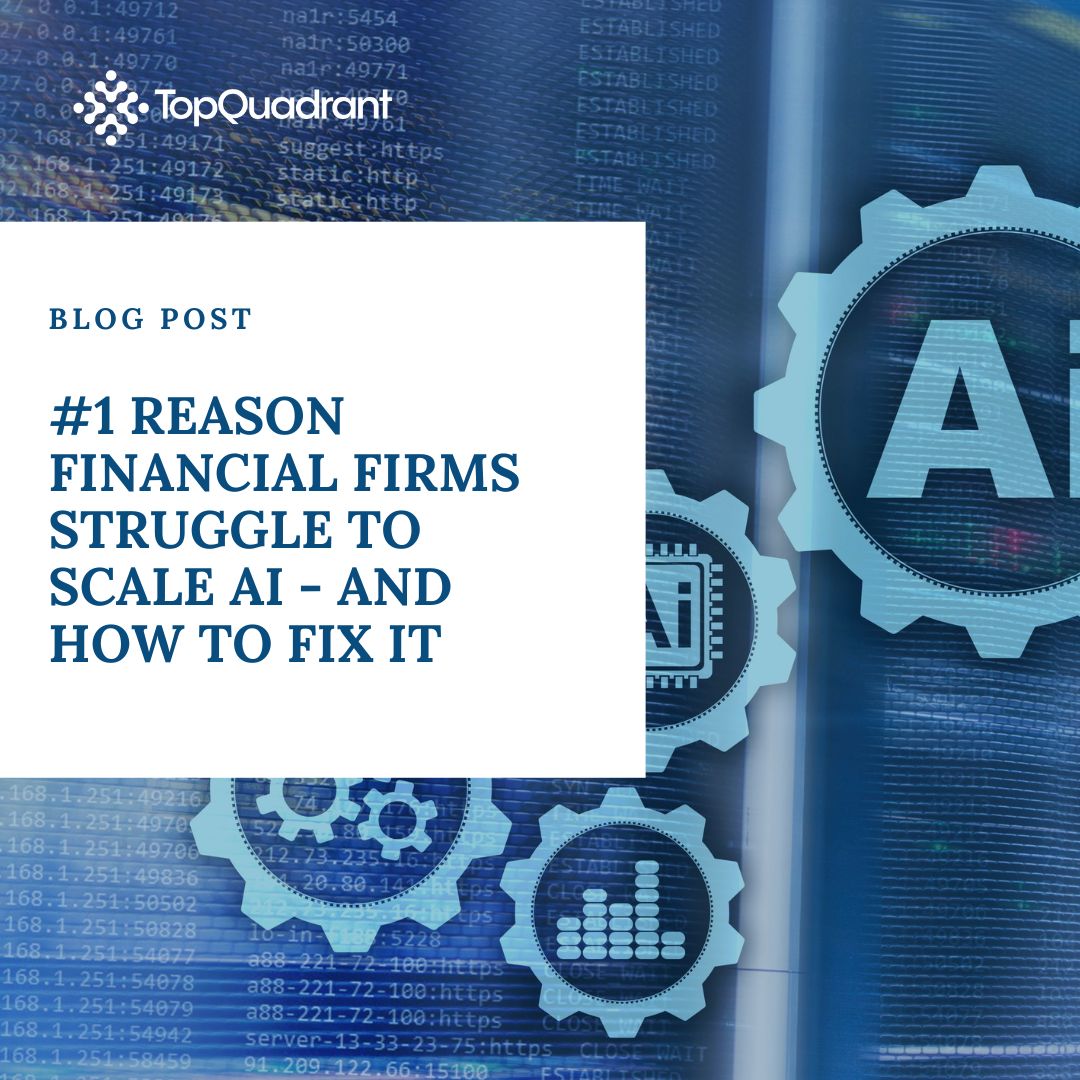Why Knowledge Graphs Are a Game Changer for Data-Driven Enterprises
Transform scattered data into connected intelligence.
TopQuadrant’s Knowledge Graphs unify your technical, business, and operational metadata into one flexible, machine-readable model – built to think like you do.
From Metadata Chaos to Meaningful Insights
Unlike rigid relational databases that struggle at scale, Enterprise Knowledge Graphs reveal the full context of your data. They understand relationships, context, and direction – guiding users to the insights they need, no matter where the data lives or what it’s called.
No more silos
Link data across departments, formats, and sources.
No more guesswork
Understand the full lineage, meaning, and quality of every asset.
No more slow starts
Deploy with prebuilt models, assistants, and 300+ ontologies.

Built to Power What’s Next
TopBraid EDG is the leading enterprise-grade platform for creating and curating Enterprise Knowledge Graphs. Trusted across industries like Pharma & Life Sciences, Financial Services, and Media & Communications
Open source and Standards based
Knowledge graphs are built on open standards and technologies, ensuring data interoperability and avoiding vendor lock-in.
Flexibility and extensibility
TopBraid EDG adapts to evolving business needs with a scalable, model-driven UI and open APIs. Its knowledge graph foundation ensures extensibility and long-term flexibility.
Inference and reasoning
Built-in reasoning uncovers relationships and insights automatically, enabling smarter governance and proactive issue detection without manual effort.

Make Your Data Work Like a Brain
Knowledge Graphs are self-descriptive. Each data point stores meaning alongside structure, using semantic models (ontologies) that grow with your business needs.
Unified: One shared model for all teams to collaborate and build on.
Flexible: Open standards let you extend and integrate freely. No vendor lock-in.
Intuitive: Designed to think like humans, enabling smarter search, discovery, and automation.
Future-Proof Your Data Strategy
Avoid the limitations of rigid, short-lived data tools. Knowledge Graphs are living systems: adaptive, extensible, and ready to solve real business problems. From privacy and compliance to drug discovery and digital twins, your next innovation starts here.
Ready to unlock what your data already knows?
Why Enterprises Need Knowledge Graphs Today
Modern organizations generate and rely on more data than ever before, yet most still struggle to use that data effectively. Information is stored in different databases, owned by different teams, described inconsistently, or locked inside legacy systems. The result is slow analysis, duplicated effort, brittle integrations, and limited trust in data quality.
Knowledge Graphs solve these challenges by turning isolated datasets into an interconnected, contextual data foundation. Instead of treating data as static records, Knowledge Graphs treat data as relationships: how things, people, processes, and rules connect. This shift is especially important for:
- Regulated industries that must prove accuracy, lineage, and compliance
- Enterprises with multiple systems, data lakes, or business units
- Organizations undergoing modernization, cloud migration, or AI adoption
- Teams struggling with inconsistent definitions or unclear ownership
By unifying business, technical, and operational metadata, Knowledge Graphs improve clarity, accelerate analytics, and become a reusable foundation for a wide range of initiatives; from data governance to digital transformation to AI.
How Knowledge Graphs Are Built: Models, Metadata, Semantics, and Standards
Knowledge Graphs are powerful because they combine meaning and structure. Rather than forcing every data source into a rigid schema, they use flexible ontologies and shared semantics to describe the real world the way humans understand it.
Semantic Models (Ontologies)
Ontologies define the “language” of a Knowledge Graph – the concepts, attributes, and relationships that matter to the business.
Examples include:
customer → owns → account
product → requires → regulatory approval
dataset → is sourced from → system
These models can be extended as the business grows, eliminating the need for disruptive data migrations.
Metadata Integration
Knowledge Graphs excel at bringing together:
- Technical metadata (schemas, APIs, tables, fields)
- Business metadata (definitions, policies, glossary terms)
- Operational metadata (lineage, quality, process flows)
This unification produces a single source of truth enriched with context and traceability.
Standards and Interoperability
Enterprise-grade Knowledge Graphs rely on open standards such as:
- RDF (Resource Description Framework)
- OWL (Web Ontology Language)
- SHACL (Shapes Constraint Language)
- SPARQL (query language)
These ensure long-term interoperability and prevent vendor lock-in — a critical concern for large organizations that need flexibility and future-proof architecture.
Reasoning and Inference
Because Knowledge Graphs understand the meaning behind data, they can automatically infer new relationships (e.g., “If A is related to B, and B to C, then A may be relevant to C”). This helps detect undocumented dependencies, governance issues, or compliance gaps before they become problems.
Real-World Use Cases for Knowledge Graphs Across Industries
Knowledge Graphs are being adopted across industries because they provide clarity, consistency, and context in environments where data is often siloed and difficult to interpret. In financial services, they help institutions better understand the relationships among customer data, products, transactions, policies, and regulatory obligations. This makes it easier to track data lineage, support audits, and deliver trustworthy insights across teams that depend on accurate and timely information.
In life sciences and healthcare, Knowledge Graphs bring together research data, trial information, product specifications, and regulatory documentation. This unified foundation improves traceability, accelerates scientific discovery, and supports more coordinated decision-making across R&D teams, clinical operations, and compliance groups.
Manufacturers rely on Knowledge Graphs to connect product data, supply chain information, equipment records, and quality documentation. When these datasets are linked, organizations gain a more complete understanding of how processes, materials, and operational decisions affect each other. This allows teams to reduce risk, resolve issues more quickly, and plan more effectively for product lifecycles and production changes.
Media and publishing organizations use Knowledge Graphs to organize large volumes of content. When articles, assets, topics, and production workflows are linked in context, it becomes much easier for teams to discover information, maintain consistent tagging practices, and streamline editorial operations.
Public sector organizations also benefit from Knowledge Graphs because they help unify information stored across many departments and legacy systems. A connected data foundation improves transparency, supports faster analysis, and strengthens the ability to enforce standards and policies across diverse agencies. Across all industries, the central value is the same: Knowledge Graphs create a shared understanding of data so that people, processes, and systems can operate with greater alignment and confidence.
How Knowledge Graphs Power AI, Automation, and Intelligent Agents
Knowledge Graphs play a central role in enabling accurate and trustworthy AI. Modern AI systems work best when they have access to structured and contextual information. A Knowledge Graph provides this structure by connecting data to its meaning, its lineage, and the relationships it has with other data. This reduces ambiguity and gives AI models a more complete foundation for generating insights.
Knowledge Graphs also improve the performance of retrieval-augmented generation systems by supplying verified, consistent, and semantically rich information. When AI models can refer to clearly defined terms, standardized concepts, and authoritative sources, the results are more accurate and aligned with enterprise policies and definitions.
Intelligent agents benefit from Knowledge Graphs as well. With a connected and semantically aware data foundation, automated agents can identify gaps, validate entries, detect emerging issues, and recommend corrections in ways that reflect actual business logic. This reduces manual effort, shortens the time required to resolve data quality or governance concerns, and supports continuous improvement.
Knowledge Graphs also help organizations prepare for emerging AI requirements. Because they are based on open standards and flexibly modeled relationships, they adapt easily as new AI technologies, regulations, and interoperability expectations evolve. This positions the Knowledge Graph as one of the most future-ready components of an enterprise data architecture and ensures that organizations can adopt new AI capabilities with confidence.
Related Resources
Unlock the Power of Knowledge Graphs and LLMs: The Ultimate Synergy for Enterprise Data
A practical overview of how LLMs and knowledge graphs work together—covering KG creation, governance, RAG, and enterprise GenAI pipelines.
